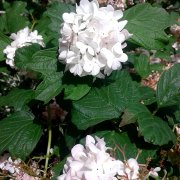Care of the shrub Viburnum opulus or Guelder rose |
|
The genus Viburnum, family Adoxaceae, includes 200 species of shrubs and trees native to the Northern Hemisphere, South America and the island of Java. Some species are: Viburnum opulus, Viburnum suspensum, Viburnum rigidum, Viburnum rhytidophyllum, Viburnum lantana, Viburnum davidii, Viburnum tinus, Viburnum tomentosum, Viburnum utile, Viburnum awabuki. Common names: Guelder-rose, Guelder rose, Common snowball, European cranberrybush. This species is native to Europe, northern Africa and central Asia. They are deciduous shrubs that reach 5 meters (16.4 feet) in height. The leaves are opposite, trilobed, dark green with a serrated margin. The white flowers appear in numerous very elegant pompoms. The fruits are very decorative red berries. Viburnum opulus needs exposure to full sun or light shade. Guelder rose resists light and occasional frosts. In spring and summer, water frequently so that the substrate never dries out completely. Reduce watering in fall and water sparingly in winter. The soil must be well drained and contain abundant organic matter. Fertilize in winter with compost or manure. In autumn fertilize once with mineral fertilizer rich in nitrogen. Prune after flowering to clear branches and remove old branches. The main enemies for Viburnum opulus are Powdery Mildew and Gray Mold. Guelder rose propagates by seeds (it's a slow process) or by cuttings in late summer, planted at a minimum temperature of 18-20 ºC (64-68 ºF). |
Images of the shrub Viburnum opulus or Guelder rose |
Find plants
Viburnum opulus or Guelder rose | Care and Growing
© 2025 FavThemes





